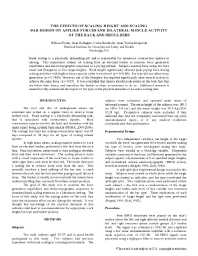Mining Publication: The Effects of Scaling Height and Scaling Bar Design on Applied Forces and Bilateral Muscle Activity of the Back and Shoulders
Original creation date: October 2006
Hand scaling is a physically demanding job and is responsible for numerous overexertion injuries in mining. This experiment studied rib scaling from an elevated bucket to examine force generation capabilities and electromyographic responses to a prying subtask. Subjects exerted force using two bars (steel and fiberglass) at five target heights. Work height significantly affected peak prying force during scaling activities with highest force capacity at the lowest level (p = 0.0188). Bar type did not affect force generation (p = 0.7843): However, use of the fiberglass bar required significantly more muscle activity to achieve the same force (p < 0.05). It was concluded that miners should scale points on the rock face that are below their knees, and reposition the bucket as often as necessary to do so. Additional research is needed to fully understand the impact of bar type on the physical demands of an entire scaling task.
Authors: WL Porter, S Gallagher, C Reinholtz, J Torma-Krajewski
Conference Paper - October 2006
NIOSHTIC2 Number: 20031497
Human Factors and Ergonomics Society 50th Annual Meeting, San Francisco, CA, Oct. 16-20, 2006; :1397-1400
See Also
- Analysis of Applied Forces and Electromyography of Back and Shoulders Muscles When Performing A Simulated Hand Scaling Task
- Analytical Investigations of Electromagnetic Location Schemes Relevant to Mine Rescue: Part I - Executive Summary; Part II - Collected Reprints - Analytical Investigations of Electromagnetic Location Schemes Relevant to Mine Rescue
- A Comparison of Fatigue Failure Responses of Old Versus Middle-Aged Lumbar Motion Segments in Simulated Flexed Lifting
- An Examination of Antecedents to Coal Miners' Hearing Protection Behaviors: A Test of the Theory of Planned Behavior
- I Can't Get Enough Air! Proper Self-contained Self-rescuer Usage
- Radio 101: Operating Two-Way Radios Every Day and in Emergencies
- Refuge Chamber Expectations Training - 1.0
- Technology News 483 - Safety Training Tools for Rock Scaling Personnel
- Technology News 535 - NIOSH Releases New Educational Video: Escape from Farmington No. 9: An Oral History
- Technology News 537 - NIOSH Develops New Mine Refuge Chamber Training
- Page last reviewed: 9/21/2012
- Page last updated: 9/21/2012
- Content source: National Institute for Occupational Safety and Health, Mining Program


 ShareCompartir
ShareCompartir
